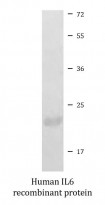ARG70030
Human IL6 recombinant protein (Active) (His-tagged, C-ter)
Human IL6 recombinant protein (Active) (His-tagged, C-ter) for SDS-PAGE
Overview
| Product Description | E. coli expressed, His-tagged (C-ter) Active Human IL6 recombinant protein |
|---|---|
| Tested Application | SDS-PAGE |
| Target Name | IL6 |
| Species | Human |
| A.A. Sequence | Val30 - Met212 |
| Expression System | E. coli |
| Activity | Active |
| Activity Note | Determined by its ability to induce proliferation in TF-1 cells The ED50 for this effect is < 0.5 ng/mL. The specific activity of recombinant human IL-6 is approximately >5 x 10^8 IU/mg. Determined by its ability to induce proliferation in MCF-7 cells. The ED50 for this effect is < 4.4 ng/mL. |
| Alternate Names | B-cell stimulatory factor 2; CDF; HSF; BSF-2; Interferon beta-2; IL-6; IFNB2; CTL differentiation factor; Interleukin-6; HGF; Hybridoma growth factor; BSF2; IFN-beta-2 |
Properties
| Form | Powder |
|---|---|
| Purification Note | Endotoxin level is less than 0.1 EU/µg of the protein, as determined by the LAL test. |
| Purity | > 98% (by SDS-PAGE) |
| Buffer | PBS (pH 8.0) |
| Reconstitution | It is recommended to reconstitute the lyophilized protein in sterile water to a concentration not less than 200 μg/mL and incubate the stock solution for at least 20 min at room temperature to make sure the protein is dissolved completely. |
| Storage Instruction | For long term, lyophilized protein should be stored at -20°C or -80°C. After reconstitution, aliquot and store at -20°C or -80°C for up to one month. Storage in frost free freezers is not recommended. Avoid repeated freeze/thaw cycles. Suggest spin the vial prior to opening. |
| Note | For laboratory research only, not for drug, diagnostic or other use. |
Bioinformation
| Gene Symbol | IL6 |
|---|---|
| Gene Full Name | interleukin 6 |
| Background | This gene encodes a cytokine that functions in inflammation and the maturation of B cells. In addition, the encoded protein has been shown to be an endogenous pyrogen capable of inducing fever in people with autoimmune diseases or infections. The protein is primarily produced at sites of acute and chronic inflammation, where it is secreted into the serum and induces a transcriptional inflammatory response through interleukin 6 receptor, alpha. The functioning of this gene is implicated in a wide variety of inflammation-associated disease states, including suspectibility to diabetes mellitus and systemic juvenile rheumatoid arthritis. [provided by RefSeq, Jun 2011] |
| Function | Cytokine with a wide variety of biological functions. It is a potent inducer of the acute phase response. Plays an essential role in the final differentiation of B-cells into Ig-secreting cells Involved in lymphocyte and monocyte differentiation. Acts on B-cells, T-cells, hepatocytes, hematopoietic progenitor cells and cells of the CNS. Required for the generation of T(H)17 cells. Also acts as a myokine. It is discharged into the bloodstream after muscle contraction and acts to increase the breakdown of fats and to improve insulin resistance. It induces myeloma and plasmacytoma growth and induces nerve cells differentiation. [UniProt] |
| Cellular Localization | Secreted. [UniProt] |
| Highlight | Related products: IL6 antibodies; IL6 ELISA Kits; IL6 recombinant proteins; Related news: HMGB1 in inflammation Inflammatory Cytokines |
| PTM | N- and O-glycosylated. [UniProt] |
Images (1) Click the Picture to Zoom In
Specific References








